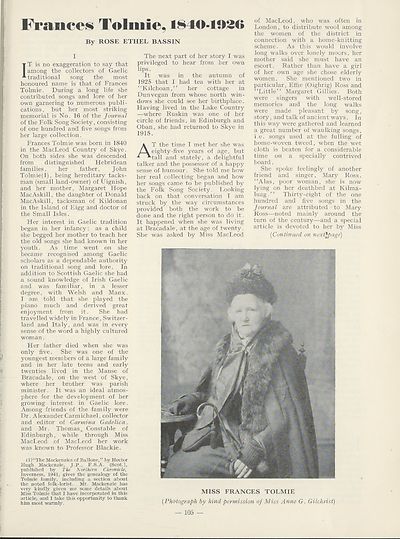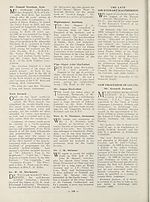An Comunn Gàidhealach Publications > Gaidheal > Volumes 44--45, January 1949--December 1950
(171) Page 105
Download files
Complete book:
Individual page:
Thumbnail gallery: Grid view | List view

Frances Tolmie, I840-1»36
By ROSE ETHEL BASSIN
IT is no exaggeration to say that
among the collectors of Gaelic
traditional song the most
honoured name is that of Frances
Tolmie. During a long life she
contributed songs and lore of her
own garnering to numerous publi¬
cations, but her most striking
memorial is No. 16 of the Journal
of the Folk Song Society, consisting
of one hundred and five songs from
her large collection.
Frances Tolmie was born in 1840
in the MacLeod Country of Skye.
On both sides she was descended
from distinguished Hebridean
families, her father, John
Tolmie(l), being hereditary tacks¬
man (small land-owner) of Uignish,
and her mother, Margaret Hope
MacAskill, the daughter of Donald
MacAskill, tacksman of Kildonan
in the Island of Eigg and doctor of
the Small Isles.
Her interest in Gaelic tradition
began in her infancy: as a child
she begged her mother to teach her
the old songs she had known in her
youth. As time went on she
became recognised among Gaelic
scholars as a dependable authority
on traditional song and lore. In
addition to Scottish Gaelic she had
a sound knowledge of Irish Gaelic
and was familiar, in a lesser
degree, with Welsh and Manx.
I am told that she played the
piano much and derived great
enjoyment from it. She had
travelled widely in France, Switzer¬
land and Italy, and was in every
sense of the word a highly cultured
woman.
Her father died when she was
only five. She was one of the
youngest members of a large family
and in her late teens and early
twenties lived in the Manse of
Bracadale, on the west of Skye,
where her brother was parish
minister. It was an ideal atmos¬
phere for the development of her
growing interest in Gaelic lore.
Among friends of the family were
Dr. Alexander Carmichael, collector
and editor of Carmina Gadelica,
and Mr. Thomas. Constable of
Edinburgh, while through Miss
MacLeod of MacLeod her work
was known to Professor Blackie.
i'l)“The Mackenzies of Ballone,” by Hector
Hugh Mackenzie, J.P., F.S.A. (Scot.),
published by The Northern Chronicle,
Inverness, ISMl, gives the genealogy of the
Tohnie family, including a section about
the noted folk-lorist. Mr. Mackenzie has
very kindly given me some details about
Miss Tolmie that I have incorporated in this
article, and I take this opportunity to thank
him most warmly.
The next part of her story I was
privileged to hear from her own
lips.
It was in the autumn of
1925 that I had tea with her at
“Kilchoan,” her cottage in
Dunvegan from whose north win¬
dows she could see her birthplace.
Having lived in the Lake Country
—where Ruskin was one of her
circle of friends, in Edinburgh and
Oban, she had returned to Skye in
1915.
AT the time I met her she was
eighty-five years of age, but
tall and stately, a delightful
talker and the possessor of a happy
sense of humour. She told me how
her real collecting began and how
her songs came to be published by
the Folk Song Society. Looking
back on that conversation I am
struck by the way circumstances
provided both the work to be
done and the right person to do it.
It happened when she was living
at Bracadale, at the age of twenty.
She was asked by Miss MacLeod
of MacLeod, who was often in
London, to distribute wool among
the women of the district in
connection with a home-knitting
scheme. As this would involve
long walks over lonely moors, her
mother said she must have an
escort. Rather than have a girl
of her own age she chose elderly
women. She mentioned two in
particular, Effie (Oighrig) Ross and
“Little” Margaret Gillies. Both
were singers with well-stored
memories and the long walks
were made pleasant by song,
story, and talk of ancient ways. In
this way were gathered and learned
a great number of wauIking songs,
i.e. songs used at the fulling of
home-woven tweed, when the wet
cloth is beaten for a considerable
time on a specially contrived
board.
She spoke feelingly of another
friend and singer, Mary Ross.
“Alas, poor woman, she is now
lying on her deathbed at Kilma-
luag.” Thirty-eight of the one
hundred and five songs in the
Journal are attributed to Mary
Ross—noted mainly around the
turn of the century—-and a special
article is devoted to her by Miss
{Continued on next^page)
— 105 —
By ROSE ETHEL BASSIN
IT is no exaggeration to say that
among the collectors of Gaelic
traditional song the most
honoured name is that of Frances
Tolmie. During a long life she
contributed songs and lore of her
own garnering to numerous publi¬
cations, but her most striking
memorial is No. 16 of the Journal
of the Folk Song Society, consisting
of one hundred and five songs from
her large collection.
Frances Tolmie was born in 1840
in the MacLeod Country of Skye.
On both sides she was descended
from distinguished Hebridean
families, her father, John
Tolmie(l), being hereditary tacks¬
man (small land-owner) of Uignish,
and her mother, Margaret Hope
MacAskill, the daughter of Donald
MacAskill, tacksman of Kildonan
in the Island of Eigg and doctor of
the Small Isles.
Her interest in Gaelic tradition
began in her infancy: as a child
she begged her mother to teach her
the old songs she had known in her
youth. As time went on she
became recognised among Gaelic
scholars as a dependable authority
on traditional song and lore. In
addition to Scottish Gaelic she had
a sound knowledge of Irish Gaelic
and was familiar, in a lesser
degree, with Welsh and Manx.
I am told that she played the
piano much and derived great
enjoyment from it. She had
travelled widely in France, Switzer¬
land and Italy, and was in every
sense of the word a highly cultured
woman.
Her father died when she was
only five. She was one of the
youngest members of a large family
and in her late teens and early
twenties lived in the Manse of
Bracadale, on the west of Skye,
where her brother was parish
minister. It was an ideal atmos¬
phere for the development of her
growing interest in Gaelic lore.
Among friends of the family were
Dr. Alexander Carmichael, collector
and editor of Carmina Gadelica,
and Mr. Thomas. Constable of
Edinburgh, while through Miss
MacLeod of MacLeod her work
was known to Professor Blackie.
i'l)“The Mackenzies of Ballone,” by Hector
Hugh Mackenzie, J.P., F.S.A. (Scot.),
published by The Northern Chronicle,
Inverness, ISMl, gives the genealogy of the
Tohnie family, including a section about
the noted folk-lorist. Mr. Mackenzie has
very kindly given me some details about
Miss Tolmie that I have incorporated in this
article, and I take this opportunity to thank
him most warmly.
The next part of her story I was
privileged to hear from her own
lips.
It was in the autumn of
1925 that I had tea with her at
“Kilchoan,” her cottage in
Dunvegan from whose north win¬
dows she could see her birthplace.
Having lived in the Lake Country
—where Ruskin was one of her
circle of friends, in Edinburgh and
Oban, she had returned to Skye in
1915.
AT the time I met her she was
eighty-five years of age, but
tall and stately, a delightful
talker and the possessor of a happy
sense of humour. She told me how
her real collecting began and how
her songs came to be published by
the Folk Song Society. Looking
back on that conversation I am
struck by the way circumstances
provided both the work to be
done and the right person to do it.
It happened when she was living
at Bracadale, at the age of twenty.
She was asked by Miss MacLeod
of MacLeod, who was often in
London, to distribute wool among
the women of the district in
connection with a home-knitting
scheme. As this would involve
long walks over lonely moors, her
mother said she must have an
escort. Rather than have a girl
of her own age she chose elderly
women. She mentioned two in
particular, Effie (Oighrig) Ross and
“Little” Margaret Gillies. Both
were singers with well-stored
memories and the long walks
were made pleasant by song,
story, and talk of ancient ways. In
this way were gathered and learned
a great number of wauIking songs,
i.e. songs used at the fulling of
home-woven tweed, when the wet
cloth is beaten for a considerable
time on a specially contrived
board.
She spoke feelingly of another
friend and singer, Mary Ross.
“Alas, poor woman, she is now
lying on her deathbed at Kilma-
luag.” Thirty-eight of the one
hundred and five songs in the
Journal are attributed to Mary
Ross—noted mainly around the
turn of the century—-and a special
article is devoted to her by Miss
{Continued on next^page)
— 105 —
Set display mode to:
![]() Universal Viewer |
Universal Viewer | ![]() Mirador |
Large image | Transcription
Mirador |
Large image | Transcription
| An Comunn Gàidhealach > An Comunn Gàidhealach Publications > Gaidheal > Volumes 44--45, January 1949--December 1950 > (171) Page 105 |
|---|
| Permanent URL | https://digital.nls.uk/127124088 |
|---|
| Description | This contains items published by An Comunn, which are not specifically Mòd-related. It includes journals, annual reports and corporate documents, policy statements, educational resources and published plays and literature. It is arranged alphabetically by title. |
|---|
| Description | A collection of over 400 items published by An Comunn Gàidhealach, the organisation which promotes Gaelic language and culture and organises the Royal National Mòd. Dating from 1891 up to the present day, the collection includes journals and newspapers, annual reports, educational materials, national Mòd programmes, published Mòd literature and music. |
|---|---|
| Additional NLS resources: |
|

